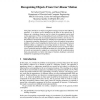Free Online Productivity Tools
i2Speak
i2Symbol
i2OCR
iTex2Img
iWeb2Print
iWeb2Shot
i2Type
iPdf2Split
iPdf2Merge
i2Bopomofo
i2Arabic
i2Style
i2Image
i2PDF
iLatex2Rtf
Sci2ools
BMVC
2000
2000
Recognizing Objects From Curvilinear Motion
This paper introduces an object recognition strategy based on the following premises: i) an object can be identified on the basis of the optical flow it induces on a stationary observer, and ii) a basis for recognition can be built on the appearance of flow corresponding to local curvilinear motion. Unlike other approaches that seek to recognize particular motions, ours focuses on the problem of recognizing objects by training on an expected set of motions. A sequential estimation framework is used to solve the implicit factorization problem, which is itself simplified in that the task is to discriminate between different objects as opposed to recovering motion or structure. Training is accomplished automatically using a robot mounted camera system to induce a set of canonical motions at different locations on a viewsphere. Experimental results are presented to support our contention that the resulting motion basis can generalize to a fairly wide range of motions, leading to a practic...
BMVC 2000 | Computer Vision | Local Curvilinear Motion | Object Recognition Strategy | Particular Motions |
| Added | 01 Nov 2010 |
| Updated | 01 Nov 2010 |
| Type | Conference |
| Year | 2000 |
| Where | BMVC |
| Authors | Tal Arbel, Frank P. Ferrie, Marcel Mitran |
Comments (0)

